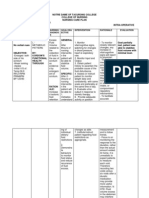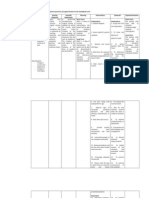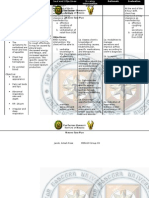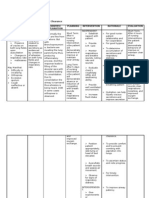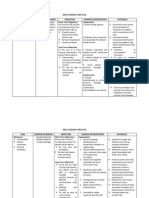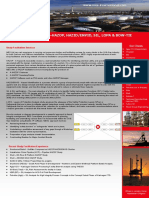Jerome Felicitas IV - Ivory: Assessment Diagnosis Analysis Planning Intervention Rationale Evaluation Goal
Jerome Felicitas IV - Ivory: Assessment Diagnosis Analysis Planning Intervention Rationale Evaluation Goal
Uploaded by
Jerome FelicitasCopyright:
Available Formats
Jerome Felicitas IV - Ivory: Assessment Diagnosis Analysis Planning Intervention Rationale Evaluation Goal
Jerome Felicitas IV - Ivory: Assessment Diagnosis Analysis Planning Intervention Rationale Evaluation Goal
Uploaded by
Jerome FelicitasOriginal Title
Copyright
Available Formats
Share this document
Did you find this document useful?
Is this content inappropriate?
Copyright:
Available Formats
Jerome Felicitas IV - Ivory: Assessment Diagnosis Analysis Planning Intervention Rationale Evaluation Goal
Jerome Felicitas IV - Ivory: Assessment Diagnosis Analysis Planning Intervention Rationale Evaluation Goal
Uploaded by
Jerome FelicitasCopyright:
Available Formats
Jerome Felicitas IV Ivory
Assessment S: marigatan nak aganges adding ko as verbalized by the patient O: o Nasal flaring o Respiratory depth changes Use of accessory muscles Difficulty of Breathing RR= 103 bpm o Diagnosis Ineffective breathing pattern related to decrease d lung expansion secondary to accumula tion of fluid in the pleural cavity. Analysis There is the accumulation of fluid in the pleural cavity, limiting the expansion of the lungs during inhalation. This causes ineffective breathing pattern. Planning Goal: o The client will be able to maintain effective lung expansion after 8 hours of effective nursing o intervention. EO: After 8 hours, the client will be able to: -have respirations within normal range Intervention Monitor vital signs especially RR. o Rationale To determine manifestations of ineffective breathing and for early initiation of intervention. to assess symptoms of cerebral hypoxia to facilitate proper breathing pattern Evaluation Goal Partially Met: The client was partially able to maintain effective lung function after 8 hours of intervention.
Assess for restlessness Position client to high fowlers position Teach relaxation techniques or exercises Administer prescribed oxygen
to reduce anxiety and improve ventilation
o o
to temporarily relieve hypoxia brought by ineffective breathing pattern
Assessment S: Medyo agkakapsot nak.. as verbalized by the client. O: o bedrest, immobility o generalized weakness pale and weak in appearance o
Diagnosis Activity intoleranc e related to bedrest/ immobility aeb verbal report of weakness.
Analysis The patient has ineffective breathing pattern, decreasing his intake of oxygen into his body. Because of that, the body couldnt tolerate activities of daily living.
Planning Goal: The patient will be able to improve activity tolerance after 8 hours of intervention. EO: The patient will be able to do the ff. after 8 hours: o
Intervention Monitor vital signs o
Rationale to recognize early signs of fatigue and anticipate needs to acquire cooperation
Evaluation Goal Partially Met: The client partially improved his tolerance on the performance of ADLs.
o o Teach patient/family the importance of mobilization o Encourage patient to mobilize her limbs by doing flexion and extension o Encourage significant others to participate in care o Encourage rest to patient
-to verbalize understanding of o the importance of mobilization -to perform ROM on all joints -to show tolerance of exercise
to facilitate blood flow and gradually promote independence and tolerance to provide encourageme nt and enjoyment
to build endurance and energy for any activity
Assessment S: No verbal complaint. O: o open lesions on the skin o
Diagnosis Risk for infection rt impaired skin integrity
Analysis As the bacteria invades the body, it damages the nerves and even causes formation of skin lesions in the skin, impairing skin integrity. This predisposes the client to infection.
Planning Goal: The patients risk for infection will decrease after continuous effective nursing intervention. EO: After intervention, the patient will be able to: o -develop no signs or symptoms indicating infection -demonstrate knowledge about measures to prevent infection o
Intervention o Monitor vital signs o o Handwashing should be practiced by both health personels, patient himself and his family Practice aseptic technique in care of the wound Monitor wounds especially the open lesions Increase I&O of client o
Rationale to detect change in status of client to prevent transmission of microorganism s and to prevent contamination
Evaluation Goal partially Met: The patients risk for infection partially decreased after continuous intervention. This is because damaged skin is still open and not fully healed.
to prevent contamination / infection to detect any redness, or drainage from the wound that may indicate infection to hydrate the skin and prevent further skin breakdown
You might also like
- Nursing Care Plan For CellulitisDocument6 pagesNursing Care Plan For CellulitisVilma Delos Reyes63% (16)
- Neufert 4th Edition ACCOMMODATIONDocument21 pagesNeufert 4th Edition ACCOMMODATIONsarannnxxx2000No ratings yet
- NURSING CARE PLAN On LeptospirosisDocument8 pagesNURSING CARE PLAN On LeptospirosisRosalie Valdez Espiritu78% (9)
- Nursing Care Plan: Epidural Hematoma Post CraniotomyDocument14 pagesNursing Care Plan: Epidural Hematoma Post CraniotomyTepperoni78% (23)
- Assessment Needs Nursing Diagnos IS Goal/Obj Ective Intervention Rationale EvaluationDocument10 pagesAssessment Needs Nursing Diagnos IS Goal/Obj Ective Intervention Rationale EvaluationApol Pen67% (3)
- Cap NCPDocument6 pagesCap NCPMarlo Parayno100% (2)
- NCPDocument5 pagesNCProxybabes100% (3)
- NCPs For ParotidectomyDocument12 pagesNCPs For ParotidectomyCarla Manaloto50% (2)
- 1 Ineffective Breathing PatternDocument7 pages1 Ineffective Breathing PatternKrisJane Ratilla Abiva100% (2)
- FactSheet AspergersDocument3 pagesFactSheet AspergersAnonymous Pj6OdjNo ratings yet
- NCPDocument6 pagesNCPAngelaTrinidadNo ratings yet
- NCP Gouty ArthritisDocument21 pagesNCP Gouty ArthritisArianne Kamille Andes67% (3)
- Nursing Care PlanDocument9 pagesNursing Care PlanjmichaelaNo ratings yet
- Nursing Care PlansDocument5 pagesNursing Care PlansMargaret SibugNo ratings yet
- Excess Fluid VolumeDocument27 pagesExcess Fluid VolumeAdrian Ardamil100% (1)
- IUFDDocument13 pagesIUFDChristopher Lontoc0% (1)
- NCP For OsteomyleitisDocument5 pagesNCP For OsteomyleitisAyaBasilioNo ratings yet
- 4 NCP's FinalDocument9 pages4 NCP's FinalZenel Yap100% (1)
- NCP IsoDocument4 pagesNCP IsoBriccio Calingin IIINo ratings yet
- NCPDocument10 pagesNCPNefre Dayap DarrocaNo ratings yet
- NCP PCAP CDocument4 pagesNCP PCAP CRio Bonifacio100% (3)
- Nursing Care Plan Ineffective Airway Clearance: Assessment Diagnosis Outcome IdentificationDocument9 pagesNursing Care Plan Ineffective Airway Clearance: Assessment Diagnosis Outcome IdentificationAngelokeizer GavinoNo ratings yet
- PTB NCPDocument12 pagesPTB NCPNiel LeeNo ratings yet
- GastroenteritisDocument8 pagesGastroenteritistanlimdania100% (3)
- Nursing Care PlanDocument10 pagesNursing Care PlanSittie Rohaina SabanNo ratings yet
- Chapter 029Document6 pagesChapter 029Jackie JuddNo ratings yet
- Nursing DiagnosisDocument3 pagesNursing DiagnosisPuspita DiahNo ratings yet
- NCPDocument17 pagesNCPShayne Jessemae AlmarioNo ratings yet
- Prefinals HADocument13 pagesPrefinals HAJireh Joy TangaraNo ratings yet
- Activity Intolerance NCPDocument6 pagesActivity Intolerance NCPDoo NahNo ratings yet
- Cardiovascular Disease Concept MapDocument5 pagesCardiovascular Disease Concept MapRye Anch100% (1)
- Unlocking The Secrets of Locked-In Syndrome: by Rachel L. Palmieri, RN-C, ANP, MSDocument46 pagesUnlocking The Secrets of Locked-In Syndrome: by Rachel L. Palmieri, RN-C, ANP, MSFarrukh Ali KhanNo ratings yet
- Assessment Nursing Diagnosis Rationale Planning Intervention/S Rationale EvaluationDocument5 pagesAssessment Nursing Diagnosis Rationale Planning Intervention/S Rationale EvaluationRachel Anne Ascaño-DavidNo ratings yet
- Acute Coronary Syndrome NCP 03Document6 pagesAcute Coronary Syndrome NCP 03AgronaSlaughterNo ratings yet
- Task English IndriDocument4 pagesTask English IndriIndri Yaplalin09No ratings yet
- NCP For FractureDocument4 pagesNCP For FracturePeejay Padigdig Feliciano100% (2)
- Nursing Care Plan FinalDocument16 pagesNursing Care Plan FinalErickson OcialNo ratings yet
- NCP BaiaeDocument7 pagesNCP BaiaeJonathan Delos ReyesNo ratings yet
- NCP JulieDocument14 pagesNCP JulieJulie Mae RubioNo ratings yet
- Nursing Care Plan - MergedDocument13 pagesNursing Care Plan - MergedJuls Flares SycaycoNo ratings yet
- NCP Laryngeal CancerDocument10 pagesNCP Laryngeal CancerAnonymous XvwKtnSrMR100% (2)
- NCP For PneumoniaDocument3 pagesNCP For PneumoniaKahMallari100% (12)
- Ncp's FOR PLEURAL EFFUSIONDocument4 pagesNcp's FOR PLEURAL EFFUSIONHania Polangi100% (1)
- Nursing Care PlansDocument10 pagesNursing Care PlansClaire Alcantara50% (2)
- Nursing Care Plan PediaDocument7 pagesNursing Care Plan PediaYvonne Niña Aranton100% (1)
- CJ C J CJ CJ Cî CJ CJ C C ! "! Cî C Ë # C Ë # CJ$ C C 0 "% C C & C C C Ë Î C "' (C Ëj "ËjDocument105 pagesCJ C J CJ CJ Cî CJ CJ C C ! "! Cî C Ë # C Ë # CJ$ C C 0 "% C C & C C C Ë Î C "' (C Ëj "ËjShirin Forbes Aquino100% (2)
- Pleural Effusion NCPsDocument7 pagesPleural Effusion NCPsJaja Nagallo100% (2)
- Alterations in The Surgical Patient Updated 2010Document122 pagesAlterations in The Surgical Patient Updated 2010hkellyrnNo ratings yet
- NCPDocument9 pagesNCPLeolene Grace BautistaNo ratings yet
- Nursing Care Plan Problem: Difficulty of BreathingDocument5 pagesNursing Care Plan Problem: Difficulty of BreathingIvan Louise Fajardo ManiquizNo ratings yet
- NCPs For ParotidectomyDocument8 pagesNCPs For ParotidectomyAcohCChao100% (1)
- Ncp'sDocument8 pagesNcp'sDuchess Kleine RafananNo ratings yet
- Assessment Nursing Diagnosis Planning Nursing Intervention Rationale Evaluation IndependentDocument4 pagesAssessment Nursing Diagnosis Planning Nursing Intervention Rationale Evaluation IndependentJoseph Rodney de LeonNo ratings yet
- NCPDocument10 pagesNCPbabycheska08No ratings yet
- NCP (Afp)Document7 pagesNCP (Afp)Summer SuarezNo ratings yet
- Scolio, Heart FailureDocument12 pagesScolio, Heart FailureArjay AvesNo ratings yet
- Nursing care process in patients with chronic obstructive pulmonary diseaseFrom EverandNursing care process in patients with chronic obstructive pulmonary diseaseNo ratings yet
- Lab Values: An Easy Guide to Learn Everything You Need to Know About Laboratory Medicine and Its Relevance in Diagnosing DiseaseFrom EverandLab Values: An Easy Guide to Learn Everything You Need to Know About Laboratory Medicine and Its Relevance in Diagnosing DiseaseRating: 4.5 out of 5 stars4.5/5 (3)
- NCLEX-RN Physiological Integrity Exam Prep :300 Practice Questions with Detailed Answers and Explanation to Master Your Exam: NCLEX-RN EXAM PREP:PRACTICE QUESTIONS AND ANSWERS, #4From EverandNCLEX-RN Physiological Integrity Exam Prep :300 Practice Questions with Detailed Answers and Explanation to Master Your Exam: NCLEX-RN EXAM PREP:PRACTICE QUESTIONS AND ANSWERS, #4No ratings yet
- By Paula Newman - MBACP (Senior Accred) Counsellor SupervisorDocument3 pagesBy Paula Newman - MBACP (Senior Accred) Counsellor SupervisorIsadora Maranhao De SousaNo ratings yet
- Benefits of Aerobic Exercise and RelatedDocument12 pagesBenefits of Aerobic Exercise and Relatedaleem_80No ratings yet
- Drill Press SafetyDocument7 pagesDrill Press Safetyreverewh ouyNo ratings yet
- Habit Canvas 3.0 Personilized PDFDocument4 pagesHabit Canvas 3.0 Personilized PDFReshmi Varma100% (1)
- Discharge Plan: MedicationDocument2 pagesDischarge Plan: Medicationmay_hisolerNo ratings yet
- Study Facilitation Capability FlyerDocument1 pageStudy Facilitation Capability FlyerAJAY1381No ratings yet
- Voluntary Health AgenciesDocument105 pagesVoluntary Health Agenciesritikaritika0% (2)
- Dietary Requirements Template-4Document4 pagesDietary Requirements Template-4Sagar PanchalNo ratings yet
- Cot 1 - Stress Management SkillsDocument44 pagesCot 1 - Stress Management SkillsRoma Dela Cruz - CayaoNo ratings yet
- Aditya BirlaDocument54 pagesAditya BirlaAbhi_IMK100% (1)
- AFRICA218Document9 pagesAFRICA218Raj Moily100% (1)
- MANN-FILTER Catálogo Europa (Online) - Comentario Del Producto Combustible PL 271 - 1Document3 pagesMANN-FILTER Catálogo Europa (Online) - Comentario Del Producto Combustible PL 271 - 1Juan Carlos Benitez MartinezNo ratings yet
- Carti Psihologie TitluriDocument2 pagesCarti Psihologie TitluriMelancholya Shin Ji MingNo ratings yet
- Bipolar Disorder Ebook by HealthyPlaceDocument21 pagesBipolar Disorder Ebook by HealthyPlacedesbest0% (1)
- SelpubDocument3 pagesSelpubapi-553587843No ratings yet
- In Process Quality Control Tests (IPQC) For Parenteral or Sterile Dosage FormsDocument27 pagesIn Process Quality Control Tests (IPQC) For Parenteral or Sterile Dosage Formsraghuraj75No ratings yet
- AmenorrheaDocument17 pagesAmenorrheaEmily EresumaNo ratings yet
- ATI RN Fundamentals Online Practice 2023 B 2024 Questions With Verified Correct AnswersDocument38 pagesATI RN Fundamentals Online Practice 2023 B 2024 Questions With Verified Correct AnswersdecotienoNo ratings yet
- Pressure Filter Design and Installation GuidelinesDocument9 pagesPressure Filter Design and Installation GuidelinesTajudeen Ibrahim0% (1)
- Human Digestive System - Wikipedia PDFDocument111 pagesHuman Digestive System - Wikipedia PDFJoshua MeyandiaNo ratings yet
- Sodium Hypochlorite Solution: 1. Product IdentificationDocument6 pagesSodium Hypochlorite Solution: 1. Product Identificationnasser kamakenNo ratings yet
- Section 1 - Chemical Product and Company Identification: Mercury Standard Solution 1.0 PPM, 1.0 MG/L As HGDocument4 pagesSection 1 - Chemical Product and Company Identification: Mercury Standard Solution 1.0 PPM, 1.0 MG/L As HGthalia wijayaNo ratings yet
- Retainer Policy FY 22Document11 pagesRetainer Policy FY 22aanchal bansal bNo ratings yet
- LeprosyDocument110 pagesLeprosyNguyễn ThànhNo ratings yet
- Cleaning Validation: WHO Supplementary Training ModulesDocument43 pagesCleaning Validation: WHO Supplementary Training ModulesvkguptajssNo ratings yet
- General Eye Care: Prepared By: Ma. Elena Fe G. Acosta, SN4, HTUDocument26 pagesGeneral Eye Care: Prepared By: Ma. Elena Fe G. Acosta, SN4, HTUmefacostaNo ratings yet
- 7 SPC 0001 R3 Protective Coating SpecificationDocument18 pages7 SPC 0001 R3 Protective Coating SpecificationChicha y LimonadaNo ratings yet
- Unit 9 Nutritional Assessment AssignmentDocument7 pagesUnit 9 Nutritional Assessment Assignmentoliviachappell13No ratings yet




